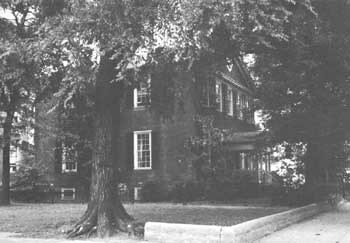





Survey of Historic Sites and Buildings
 |
JOHN MARSHALL HOUSE Virginia |
|
| ||
Ownership and Administration. City of Richmond; Association for the Preservation of Virginia Antiquities.
Significance. John Marshall—statesman, diplomat, and probably the most influential Chief Justice of the Supreme Court in history—built this house in 1790, when he was emerging as a leader of the Federalist Party in Virginia, and lived in it intermittently for the next 45 years.
Born in a log cabin and raised on the Virginia frontier, Marshall received an informal education from his father, a member of the Virginia House of Burgesses. When the War for Independence broke out, young Marshall became a lieutenant in the Virginia Militia. Except for one summer while he attended law lectures at the College of William and Mary, for 6 years he lived the life of a soldier. After the war he set up a law practice in Richmond and soon entered State politics; he was a member of the legislature and participated in the convention that ratified the Constitution. He gained national attention as a result of his diplomatic mission to France in 1797 during the XYZ affair. After returning from France, he ran for Congress and won a seat in the House of Representatives. During his term he became a close friend of John Adams, who, in 1800, appointed him Secretary of State.
Marshall was Chief Justice of the Supreme Court between 1801 and 1835. During that time he greatly strengthened the judiciary branch of the Federal Government and handed down many decisions of long lasting national significance—based on a broad interpretation of the Constitution and a belief in the supremacy of National over State power. Because the new Jefferson administration viewed the Supreme Court as a stronghold of the defeated Federalists, primarily because Marshall molded the court in his own image, Jefferson frequently clashed with Marshall—especially when the latter acquitted Aaron Burr of treason. Marshall undoubtedly drafted many of his decisions at his home in Richmond, where he also played host to leaders in all branches of U.S. life.
 |
| John Marshall built this home in Richmond in 1790, at the beginning of his distinguished career—a career climaxed by 34 years of service as Chief Justice of the Supreme Court. He lived in it until his death, in 1835. |
Present Appearance. The house is a square brick building that originally consisted of six rooms and a basement. In 1810 Marshall added a downstairs bedroom at the rear of the house. Exterior ornamentation is simple: A pedimented gable, modillioned cornice, and two small porches. The house is furnished with period items, and a small museum upstairs contains Marshall items, including one of his judicial robes. No original outbuildings have survived. The house, which in 1909 the city of Richmond purchased from the Marshall family, is open to the public.
NHL Designation: 12/19/60
 |
 |
http://www.cr.nps.gov/history/online_books/founders-frontiersmen/sitec43.htm
Last Updated: 29-Aug-2005